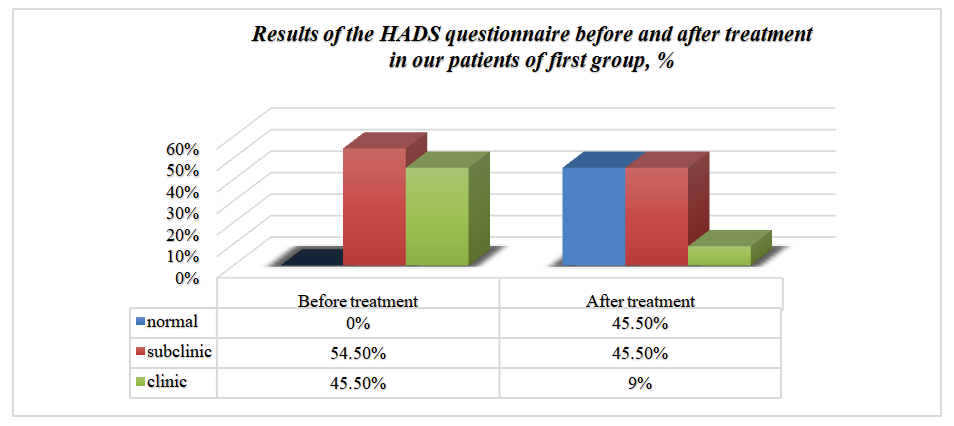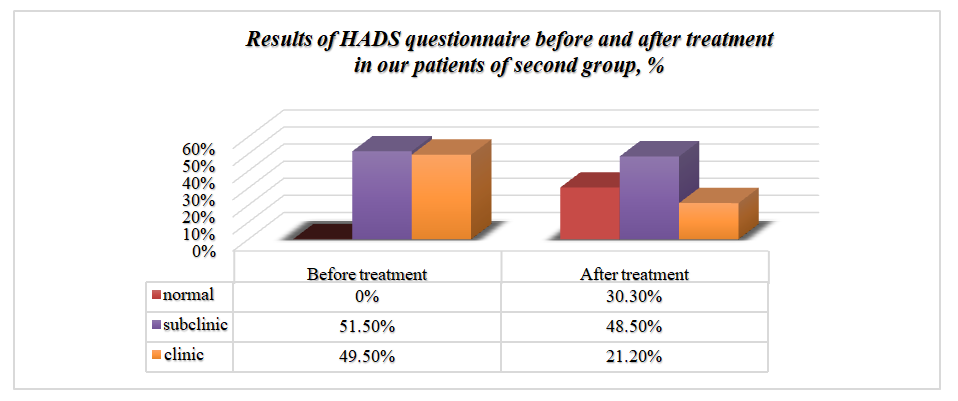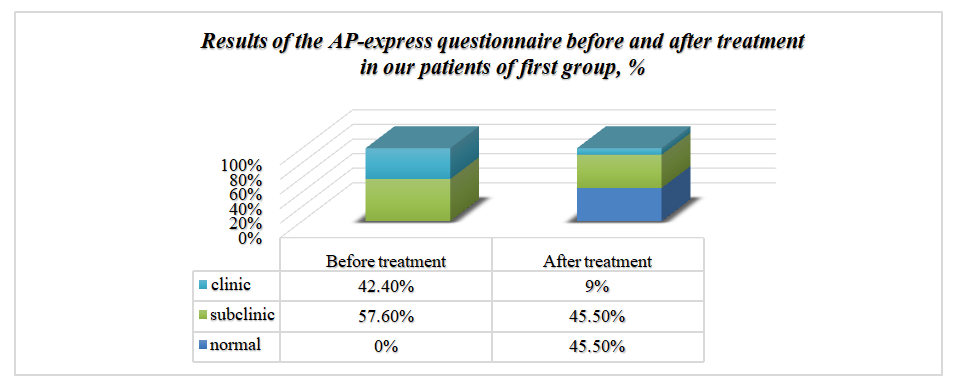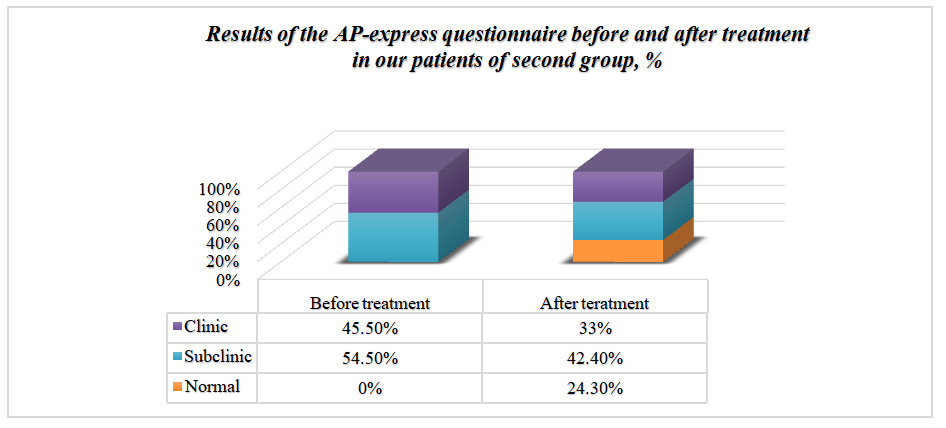-
Paper Information
- Next Paper
- Previous Paper
- Paper Submission
-
Journal Information
- About This Journal
- Editorial Board
- Current Issue
- Archive
- Author Guidelines
- Contact Us
American Journal of Medicine and Medical Sciences
p-ISSN: 2165-901X e-ISSN: 2165-9036
2024; 4(2): 278-281
doi:10.5923/j.ajmms.20241402.24
Received: Jan. 7, 2024; Accepted: Feb. 3, 2024; Published: Feb. 8, 2024

Clinical Structure and Psychocorrection of Psychoemotional Disorders in Patients with Hypothyroisis
Ollaberganova Rokhila Zokhirzhanovna, Ibadullaev Bekzod Bakhromovich
Urgench Branch of Tashkent Medical Academy, Urgench, Uzbekistan
Copyright © 2024 The Author(s). Published by Scientific & Academic Publishing.
This work is licensed under the Creative Commons Attribution International License (CC BY).
http://creativecommons.org/licenses/by/4.0/

This article is about the formation of the structure of developed psychoemotional disorders in patients with hypothyroidism and the provision of effective medical and psychological assistance.
Keywords: Hypothyroidism, Anxiety, Depression, Psychocorrection
Cite this paper: Ollaberganova Rokhila Zokhirzhanovna, Ibadullaev Bekzod Bakhromovich, Clinical Structure and Psychocorrection of Psychoemotional Disorders in Patients with Hypothyroisis, American Journal of Medicine and Medical Sciences, Vol. 4 No. 2, 2024, pp. 278-281. doi: 10.5923/j.ajmms.20241402.24.
1. Introduction
- Today, the number of somatic diseases in our region is increasing year by year, according to WHO data, about 200 million of the world's population suffer from thyroid diseases, and it was found that the majority of these indicators are patients with hypothyroidism and thyrotoxicosis. According to the data, the incidence of hypothyroidism, i.e. thyroid hormone deficiency, is 0.2-2.0% to 4.6-9.5% of patients compared to the general population. According to the data, the incidence of hypothyroidism, i.e. thyroid hormone deficiency, is 0.2-2.0% to 4.6-9.5% of patients compared to the general population.. Some data have shown that the incidence of hypothyroidism increases with biological age, and the prevalence of hypothyroidism in older women is 12-21%, the most common type of hypothyroidism among them is subclinical hypothyroidism, with an age- and sex-dependent incidence of 1.2%. -15%, and at the same time, it is diagnosed 3-10 times more often in women than in men. The second most common thyroid disease is thyrotoxicosis, which is a diffuse toxic increase in thyroid hormone levels in patients with a prevalence of 2.7% in women and 0.2% in men. It is clear from the above indicators that hypothyroidism and thyrotoxicosis are the leading diseases among thyroid gland diseases [1,2]. This, in turn, shows that it is one of the factors that indicate the relevance of the topic. One of the second relevant aspects of the issue is the clinical course of both pathologies in patients, in addition to somatic and vegetative disorders, patients with these diseases suffer from mental problems that have the highest impact on the course of the disease, because whether the patient has hypothyroidism or thyrotoxicosis patients have psychoemotional problems against the background of thyroid hormone imbalance. and cognitive disorders such as anxiety, depression, asthenia, memory and attention deficits develop. The development of such psychological problems does not fail to affect the quality of life of patients, which is one of the factors that indicate the need for not only therapeutic, but also medical-psychological support for patients [3,4,5,6].The Purpose. Determining the level of anxiety-depressive and anxiety-phobic disorders in patients with hypothyroidism and conducting psychocorrection.
2. Material and Methods
- Among our 66 patients diagnosed with hypothyroidism (39+1.1), who came to the private clinic of Alfa-med service with psychoemotional disorders, the somatic condition of our patients when they came to the clinic for treatment, is studied based on their complaints, anamnesis, objective and subjective, paraclinical data. A special medical-psychological questionnaire was used to assess the mental status of our patients. When assessing the type and degree of psychoemotional disorders in patients, the following psychometric tests were used as a basis in our work:In order to determine the structure of developed anxiety-depressive and anxiety-phobic disorders in our patients, HADS and the AP-express questionnaire for the detection of anxiety-phobic disorders were used.In our study, psychocorrection of psychoemotional disorders was carried out by dividing patients into two groups:Our patients in the first main (n=33) group were treated with basic treatment + cognitive-behavioral psychotherapy, and in the 2nd comparison group (n=33) with basic treatment + rational psychotherapy for 2 months in an outpatient setting. The resulting analyzes were statistically analyzed as follows.Rational psychotherapy and cognitive-behavioral psychotherapy were selected from the psychotherapeutic methods performed on patients, the distribution of our patients was as follows: (Table 1)
|
3. Results
- When the indicators of psychometric tests conducted in our patients were analyzed statistically before and after treatment, the following results were formed:
 | Figure 1 |
 | Figure 2 |
 | Figure 3 |
 | Figure 4 |
4. Conclusions
- Based on the obtained analysis, we should say that timely psychometric analysis of the mental state of patients with somatic diseases allows early identification of the mental factors that have the greatest influence on the course of the disease, and in turn, timely medical and psychological correction together with therapeutic processes, patients not only affects the quality of life, but also affects the development of dangerous complications in them. In our study, the cognitive-behavioral psychotherapy conducted in patients with hypothyroidism, compared to rational psychotherapy, improved the mental state of patients and significantly reduced their depressive, anxiety, and phobic disorders. It was proven during our observations leading to the level of efficiency.
 Abstract
Abstract Reference
Reference Full-Text PDF
Full-Text PDF Full-text HTML
Full-text HTML